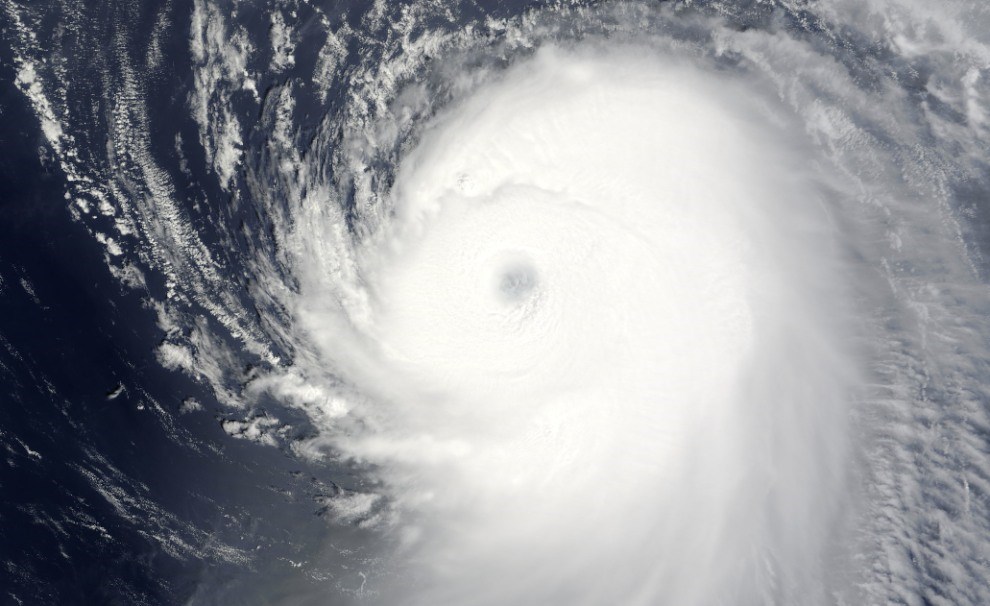Part of a series of articles titled Coastal Geomorphology—Tropical Storms.
Previous: Storm Surge
Article

NOAA image.
In the early 1970s, Herbert Saffir, an engineer, and Robert Simpson, a meteorologist, developed a scale to describe the likely effects that hurricanes could have on an area. The scale has five categories, increasing in intensity from 1 to 5. Initially, Saffir and Simpson created the scale based solely on wind speed. Later, Simpson added storm-surge levels. Low atmospheric pressure is also associated with hurricanes.
| Category | Wind speed | Storm surge (height above normal) | Atmospheric pressure (millibars) | Damage |
| 1 | 74–95 mph (119–153 kph) |
4–5 ft (1.2–1.5 m) |
>979 | Minimal: No real damage to buildings. Damage to unanchored mobile homes. Some damage to poorly constructed signs. Some coastal flooding and minor pier damage. |
| Examples: Cindy and Ophelia (2005) | ||||
| 2 | 96–110 mph (154–177 kph) |
6–8 ft (1.8–2.4 m) |
965–979 | Moderate: Some damage to building roofs, doors, and windows. Considerable damage to mobile homes. Damage to piers from flooding. Small craft in unprotected moorings may break their moorings. Some trees blown down. Evacuation of some shoreline residences and low-lying areas required. |
| Example: The Perfect Storm (1991), Hurricane Isabel (2003) | ||||
| 3 | 111–130 mph (178–209 kph) |
9–12 ft (3–4 m) |
945–964 | Extensive: Some structural damage to small residences and utility buildings. Large trees blown down. Mobile homes and poorly built signs destroyed. Flooding near the coast destroys smaller structures with larger structures damaged by floating debris. Terrain may be flooded well inland. Evacuation of low-lying residences within several blocks of the shoreline may be required. |
| Examples: Dennis, Katrina, Rita, and Wilma (2005) | ||||
| 4 | 131–155 mph (210–249 kph) |
13–18 ft (4–5.5 m) |
920–944 | Extreme: More extensive failure on non-bearing, exterior walls with some complete roof structure failure on small residences. Major erosion of beach areas. Terrain may be flooded well inland. Massive evacuation of residential areas as far inland as 6 mi (10 km) may be required. |
| Example: Galveston Hurricane of 1900 | ||||
| 5 | >155 mph (249 kph) |
>18 ft (5.5 m) |
<920 | Catastrophic: Complete roof failure on many residences and industrial buildings. Some complete building failures with small utility buildings blown over or away. Flooding causes major damage to lower floors of all structures near the shoreline. Massive evacuation of residential areas on low ground within 5 to10 mi (8 to 16 km) of the shoreline may be required. |
| Example: Andrew (1992) | ||||
Sources: Blake et al. (2007), National Weather Service (2009a), NOAA National Hurricane Center (http://www.nhc.noaa.gov/HAW2/english/basics/saffir_simpson_printer.shtml; accessed 6 January 2010).

NASA image.
Because storm surge values are highly dependent on the slope of the continental shelf in the landfall region, wind speed is the determining factor in the Saffir-Simpson hurricane scale (National Weather Service 2009a). Yet, hurricanes are much more than wind events. For instance, based on wind speed, Hurricane Katrina (2005) initially came ashore in Florida as a category 1 hurricane and made a second landfall in Louisiana as a category 3. However, storm surge associated with Hurricane Katrina was over 30 ft (9 m) in some areas, which would classify it as a category 5 hurricane.
Another example is Hurricane Ike (2008). While in the Gulf of Mexico, Ike downgraded to a category 2 hurricane as it approached the Texas shoreline. Possibly because local residents, who were following the weather reports, saw the storm weaken to a category 2, they decided to not evacuate their homes. As a result, 112 people died. Hurricane Ike actually caused storm surge typical of a category 4 or 5 hurricane along the Texas coast. Possibly fewer residents would have tried to weather the storm had it been classified based on storm surge. This tragic example illustrates the significance of storm surge as well as wind speed in classifying a hurricane.
Part of a series of articles titled Coastal Geomorphology—Tropical Storms.
Previous: Storm Surge
Last updated: June 4, 2019